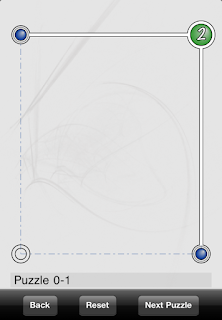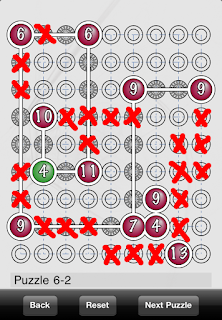CounterBalanceE is a logic puzzle for iPhone and iPad by George Menhorn which was originally released back in 2009.
A free version called CounterBalancE Lite is also available.
The concept is pretty good and original.
You start with a grid containing some holes and some labelled nodes, like this:
The goal is for the total length of the links starting from each labelled node to be equal to the label of the node. So the solution of the above puzzle would be:
Note that the solution above is not unique, because you could put an extra node in the bottom left corner. However, that node wouldn't contribute to the solution in any way since it wouldn't develop any new link to a numbered node. This is true for every puzzle included in the game: there is always a single solution except for the occasional possibility of adding additional, isolated, nodes.
Can the puzzles be solved with logic alone, without resorting to trial and error?
I suspect they could, however the game doesn't give the player the means to do so.
As an example, here's one of the puzzles at the highest difficulty level:
At first glance this might seem discouraging, but simply counting the lengths of the possible links, one can exclude a good number of cells:
Then, with a few more logical steps never involving trial and error, the solution is eventually reached:
That's a shame: simply adding the ability to put down a cross by tapping and holding on a cell would make the game a lot deeper and enjoyable. As it currently is, the more difficult puzzles feel more like randomly moving nodes around attempting to get closer to the solution.
Update 14/02/2013: George Menhorn kindly answered to this review, promising to add this feature in a future update. Thanks George!
Another annoyance is that the current position isn't saved when sending the app to the background, so if you don't solve a puzzle in a single session, you risk having to start from scratch the next time you run the game.
A final nitpick is that the red/green color of the nodes is the only clue (short of counting the length of all the links) of whether a node is correctly connected or not. This might make it difficult for color blind people to play the game. For example here is a simulation of how a person with protanopia would see the puzzle above; it's pretty difficult to see that one of the 4's is of a different color.
This is still a very good logic puzzle and for 99 cents I can wholeheartedly recommend it, but if the user interface were improved, it would become excellent.
Summary
| Nontrivialness | ★★★★★ |
| Logical Reasoning | ★★★☆☆ |
| User Interface | ★★☆☆☆ |
| Presentation | ★★★☆☆ |
| Loading Time | ★★★★★ |
| Saves Partial Progress | ✘ |
| Status Bar | ✔ |
©2013 Nicola Salmoria. Unauthorized use and/or duplication without express and written permission is strictly prohibited. Excerpts and links may be used, provided that full and clear credit is given to Nicola Salmoria and nontrivialgames.blogspot.com with appropriate and specific direction to the original content.







